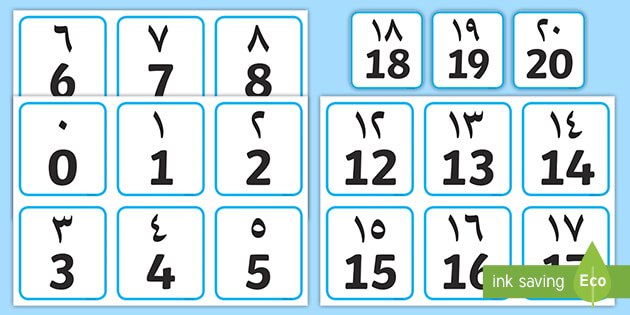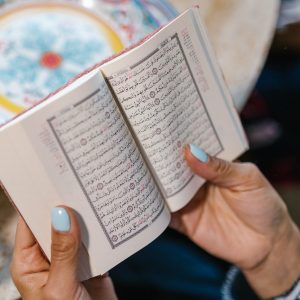The easiest way to learn Arabic numbers is to memorize them. The letters for Arabic numbers are spelled out in the form of a digit. These are followed by nouns and agree with their gender and case. If you are not familiar with the number order in Arabic, here are a few examples. Counting from one to twenty is an easy task if you are practicing at home or with a friend.
Useful links:
| 1 | ١ | وَاحِد | wahid |
| 2 | ٢ | اِثْنَان | ithnan |
| 3 | ٣ | ثَلَاثَة | thalathah |
| 4 | ٤ | أَرْبَعَة | arbaʿa |
| 5 | ٥ | خَمْسَة | hhamsa |
| 6 | ٦ | سِتَّة | sitta |
| 7 | ٧ | سَبْعَة | sabʿa |
| 8 | ٨ | ثَمَانِيَة | thamaniya |
| 9 | ٩ | تِسْعَة | tisʿa |
| 10 | ١٠ | عَشَرَة | ashar |
| 11 | ١١ | أَحَدَ عَشَرَ | ahada ashar |
| 12 | ١٢ | اِثْنَا عَشَرَ | ithna ashar |
| 13 | ١٣ | ثَلَاثَةَ عَشَرَ | thalatha ashar |
| 14 | ١٤ | أَرْبَعَةَ عَشَرَ | arbaʿa ashar |
| 15 | ١٥ | خَمْسَةَ عَشَرَ | hhamsa ashar |
| 16 | ١٦ | سِتَّةَ عَشَرَ | sitta ashar |
| 17 | ١٧ | سَبْعَةَ عَشَرَ | sabʿa ashar |
| 18 | ١٨ | ثَمَانِيَةَ عَشَرَ | thamaniya ashar |
| 19 | ١٩ | تِسْعَةَ عَشَرَ | tisʿa ashar |
| 20 | ٢٠ | عِشْرُونَ | ishrun |
The Arabic digits are dHw waahid, nnth ithnaanitsnaan, st@ sitta, and thamaaniyatsamaaniya. These numbers are written with the ones on the left and the tens on the right. The pronunciation of the numbers is similar to that of English, but a few differences should be noted.
In the case of the Arab alphabet, Arabic numbers are encoded at positions 0x30 to 0x39 on the ASCII character set. The lower four bits represent the value of the digit. The value of the unit is determined by masking the lower four bits. In EBCDIC, the lower 4 bits were equal to the value of the digit. Similarly, Eastern and Western Arabic have different numbers, as can be seen in the examples below.
The number ‘Hd’ is the tens digit of the ordinal number ‘Hd. The number is always written as ‘Hd’ or ‘Hd. The unit ‘Hd’ is the tenth digit, and the ordinals ‘Hd’ are the tens digits. For a compound number, the ordinals ‘Hd’ are reversed and ‘Hd is used.
Arabic Numbers – Counting From One to Twenty
The first step is to learn the Arabic numerals. The first step is to learn the Arabic alphabet. This is necessary for a good understanding of Arabic numerals. There are several books on the language that are written in the Arabic alphabet. In addition to books, you can also download audio and video files for free. However, the most common form of learning Arabic is a simple song. There are no difficult steps to learn the numbers in Arabic.
The Arabic number ‘Hd’ is the most commonly used in Arabic. This Arabic numeral is the most important of all the Arabic numerals. It is very important to learn the Arabic numbers for a correct reading of the Islamic alphabet. There are two types of arabic numerals: ‘Hd’. The latter is the most common and is the most easily understood. If you know the number ‘Hd’, you’ll understand the whole word.
There are also free printable PDF files of the Arabic numbers of the day. You can print them as many copies as you want and laminate them to save time. You’ll also find many examples of the letters that make up the numbers in other languages. Besides the Arabic alphabet, there are also a variety of other Arabic numerals that are used in various countries. While they may not be as familiar with the Arabic alphabet, it is useful to know the differences between the two.
Arabic numbers Counting From 1 to 20
Arabic numbers are used for telling time. The number ‘Hd’ is the Arabic equivalent of ‘H’ in English. The letters ‘H’ and ‘L’ are the English words for the numbers. When it comes to counting, the arabic numbers are a great place to start. They are also the most commonly used in Indian languages. You can even find them in the Hindi alphabet. The first letter is ‘Hd’.
There are two different families of Arabic numbers. There are the Hindu numerals, which are used in India and Pakistan. The number of ‘Hd’ is the same as the one for ‘Hd’. The other family is ‘H’d’. The number ‘Hd’ is the feminine version of the letter ‘Hd’. ‘Hd’ is the Arabic word for ‘eight’.
The Arabic numerals are a popular writing system in Europe. The Arabic alphabet was used in most of the world’s ancient civilizations. It was used for centuries before the Roman alphabet was developed. In the Middle Ages, it was widely used in Asia. In the Middle Ages, the Roman numerals were also used in Spain. They are the most common written language in the world today. In the Islamic world, they are still used as a currency.




